Listen to the water
Play a listening game and discover how the sounds of water make you feel.

Overview
Guided by information about Indigenous Peoples’ beliefs about the healing and spiritual powers of water, students play a listening game, matching the sounds of water to water sources in nature. They select two sounds they believe are the most helpful in bringing inner peacefulness to people.
Instructions
What you'll need
- "Listen to the water" slides, please use Adobe Acrobat or Adobe Acrobat Reader to open for audio to work
- Screen and projector
- Audio system to play the sounds on the slides
- Open up the "Listen to the water" slides. Show slide 2 and ask your students, “How do the sounds of water make you feel?” Note students’ suggestions for use later in this activity.
- Briefly explain to your students they will play a listening game. There will be two images on each slide that they see: their challenge is to use the audio clues to each slide that they to help identify the source of the water.
- Begin with the first images and sound on slide 5 (press the sound icon to listen). Show the next slide to reveal the answer. Continue this pattern with slides 7-14.
- Show your students slide 15 and ask them how the different sounds made them feel. Add their ideas to the class list.
- Show slide 16 and ask your students to choose the two sounds that made them feel the most peaceful. Invite students to share their choices and thinking with the class.
- To conclude the activity, ask your students to draw a picture of how sound from their choice of water source makes them feel.
Modify or extend this activity
Modification
- After students listen to each sound, invite them to suggest in which season the sound was recorded. How would the sound change in different weather or a different season?
Extension
- Invite students to choose a water source (e.g., creek, lake, ocean) and then create their own audio clues of the sound that the water makes.
- Take your students outside and go for a listening walk. When you hear a sound, ask students to tell you how the sound makes them feel. If possible, visit a nearby stream and listen to the water.
Curriculum Fit
Kindergarten Science
Big idea
- The motion of objects depends on their properties
- Daily and seasonal changes affect all living things
Content
- Properties of familiar materials
- Weather changes
- Seasonal changes
Curricular competencies
Questioning and predicting
- Demonstrate curiosity and a sense of wonder about the world
Planning and conducting
- Make exploratory observations using their senses
Processing and analyzing data and information
- Recognize First Peoples stories, songs, and art, as ways to share knowledge
- Discuss observations
Applying and innovating
- Take part in caring for self, family, classroom and school through personal approaches
Grade 1 Science
Big idea
- Light and sound can be produced and their properties can be changed
Content
- Natural and artificial sources of light and sound
- Properties of light and sound depend on their source and the objects with which they interact
- Local First Peoples knowledge of the local landscape, plants and animals
Curricular competencies
Questioning and predicting
- Demonstrate curiosity and a sense of wonder about the world
Processing and analyzing data and information
- Recognize First Peoples stories, songs, and art, as ways to share knowledge
Applying and innovating
- Take part in caring for self, family, classroom and school through personal approaches
Assessments
Assess students’ ability to:
- Ask thoughtful questions
- Use audio clues to make inferences
- Transfer and apply learning to new situations
Teaching Notes
How this activity was developed
These materials were created with guidance from Indigenous educators, subject matter experts and thought leaders to help draw upon important teachings, learnings, and Indigenous perspectives.
For centuries, the traditional western view of water has often been focused on its value as a resource. Indigenous people have a unique relationship with the waters of British Columbia. Since time immemorial, water has played a sacred role and is seen as a living entity. How water is used must be carefully considered with a view towards not just the immediate need and impact, but the needs and perspectives of generations to follow.
We are dedicated to deep listening and respectfully highlighting Indigenous ways of knowing in the materials we provide B.C. educators. If you have any feedback for us on these activities, or suggestions for others, please email schools@bchydro.com. We would love to hear from you.
About the artist
The design of the worksheets in this activity was a collaborative effort with Indigenous artist Kelli Clifton. Kelli Clifton was born and raised in Prince Rupert, British Columbia and is Gitga’at from the community of Hartley Bay. Clifton is interested in using her artwork as a form of storytelling—especially in relation to her Ts’msyen language (Sm’algyax), her coastal upbringing and her experiences as an Indigenous woman. Clifton currently lives in her home community where she continues to practice her art and teaches Sm’algyax at a local high school. Learn more about Clifton's art on her Facebook page.
BC Hydro’s commitment to reconciliation
BC Hydro exists to serve British Columbians by providing clean, reliable and affordable electricity. We recognize that maintaining and developing the system has impacts on the lives and interests of Indigenous people. To support our move towards true and lasting reconciliation, BC Hydro will acknowledge past wrongs, listen to Indigenous perspectives and seek shared understanding with First Nations communities and governments.
Learn more about our Statement of Indigenous Principles.







